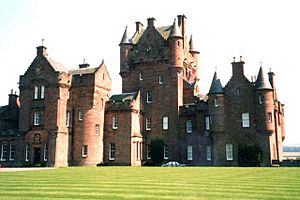Ayton Castle, Scottish Borders facts for kids
Quick facts for kids Ayton Castle |
|
|---|---|
| Part of Scottish Borders | |
| Near Ayton | |

Ayton Castle
|
|
| Coordinates | 55°50′44″N 2°06′53″W / 55.8456°N 2.1148°W |
| Type | Castle |
| Site history | |
| Built | c.15th century |
Ayton Castle is a cool old castle found near Ayton in the Scottish Borders, Scotland. It's about 9 kilometers (about 5.6 miles) north-west of a town called Berwick-upon-Tweed. The castle you see today was mostly built in the 1800s, but it stands on the spot of a much older medieval tower. Ayton Castle was once the main home for the powerful Ayton family. It's now a very important historical building, protected as a 'category A listed building'. This means it's super special and needs to be preserved. Its beautiful gardens are also officially recognized as important historical landscapes in Scotland.
Contents
The Story of Ayton Castle
Early Days and Battles
The first castle here was a peel tower, which was a strong tower built to defend against attacks. It belonged to the Home family. In 1497, the English army captured this castle. After the battle, a peace agreement called the treaty of Ayton was signed in the nearby church on September 30, 1497. Later, the old tower was replaced by a grand house, but sadly, it burned down in 1834.
Building a New Castle
After the fire, a man named William Mitchell bought the land. He was a very important person at the Royal Bank of Scotland. He later added "Innes" to his name, becoming William Mitchell-Innes. In 1851, he decided to build a brand new castle. He hired a famous architect named James Gillespie Graham. The new castle was built in the Scottish Baronial style, which looks like an old Scottish fortress, using red sandstone.
Castle Additions and Famous Visitors
The castle grew even bigger over the years. In 1860, another architect, David Bryce, added a drawing room and a billiard room. More parts were added between 1864 and 1867 by James Maitland Wardrop. The inside of the castle was also beautifully redecorated in 1875.
Ayton Castle has some interesting features. It has a unique beehive-shaped dovecote (a building for doves or pigeons) from the 1500s. There's also a grand South Lodge, which is like a gatehouse, made of red sandstone.
A very famous visitor to the castle was the American writer Mark Twain in 1873. He loved the fireplace mantel in the dining room so much that he insisted on buying it! That fireplace is now in the Mark Twain House & Museum in Hartford, Connecticut, USA. The castle has a new fireplace in its place now.
Changes in Ownership
When William Mitchell-Innes passed away in 1860, his eldest son, Alexander Mitchell-Innes, took over the castle. Alexander continued to improve the estate. He had a new church built for the parish, complete with a tall 36-meter (about 118 feet) spire and beautiful stained-glass windows.
Alexander had a very large family. Because of this, the castle and its lands were sold in 1895 for £90,000 to Henry Liddell-Grainger. The money from the sale was shared among Alexander's many children. The family kept some other properties nearby, but Ayton Castle itself changed hands.
Images for kids



